The Story of a Cricket Stained Glass Window
Martin Chandler |Published: 2016
Pages: 80
Author: Hayhurst, Keith
Publisher: Max Books
Rating: 4 stars

When I first learned that this book had been published I decided it was probably a self-indulgent flight of fancy and not something I therefore needed to add to my collection. There was a bit of soul-searching along the way, as I knew there was a Lancashire connection, but this was a temptation I thought I could and should resist.
What eventually broke my resolve was learning that the publisher had produced a limited edition, sixty signed and numbered copies in a special cloth binding. What is a bibliophile to do? So I ordered a copy of the book, all lingering doubts being overcome by the modest £25 price tag on the limited edition.
Author Keith Hayhurst has written of Lancashire cricket before, and he holds a number of positions at Old Trafford, most notably as curator of the Club’s museum. The story he relates began half a century ago when he first learnt that the Lancashire and England all-rounder of the Victorian era RG ‘Dick’ Barlow had installed, in his home, a stained glass window depicting himself, his famous opening partner AN ‘Monkey’ Hornby together with their Lancashire and England teammate, wicketkeeper Richard Pilling.
The question to which Hayhurst sought an answer was what had happened to the window, and the early part of the book charts the enquiries he diligently pursued before, eventually, finding it located in Southport in the home of Barlow’s illegitimate son, a man who had gone on to be a successful businessman. Hayhurst persuaded the son to leave the window in his Will to the county club, so having completed his mission in his role as museum curator Hayhurst now finds himself responsible for this unique item of memorabilia.
The Story of a Cricket Stained Glass Window is a fascinating little book. The story of the search is interesting enough, but also enjoyable are the stories of Barlow, Hornby and Pilling. There is the occasional mention of a few of Barlow’s most stirring on field displays, but whilst this may be a cricket book it is not a book about cricket and the reader learns as much about Barlow the man as he or she will from the full biography of Barlow that I understand will be published in the not too distant future.
It wouldn’t be right to write at any length about Barlow and Hornby without touching on the subject of Francis Thompson, the poet responsible for the famous piece of cricketing poetry that will link their two names in perpetuity. Hayhurst includes the sadly all too brief story of Thompson’s life without, I am happy to report, giving houseroom to the ludicrous recent theory that he might have been the notorious mass murderer ‘Jack the Ripper’. At Lord’s is also reproduced in full and as a result I read the entire poem for the first time in many years. It is still uneven in quality, but the first verse remains a wonderful and atmospheric piece of writing, and is particularly thought provoking when read in the light of Hayhurst’s summary of Thompson’s life.
A good deal of the book is taken up with a selection of excellent photographs. Some are very familiar, but have rarely been as well reproduced as they are here. There are also many which have not appeared in print before, and all contribute to a very satisfying end product. The limited edition, as with all such that this publisher have produced, is very well done, and on the basis that the standard edition is the same book in a plain card binding it will be just as satisfying a read. This is an excellent and unusual book. It is highly recommended.






I have met Keith hayhurst, a nice man but not one of cricket’s most knowledgeable
chaps.
Comment by paul mullarkey | 12:19am BST 2 August 2016